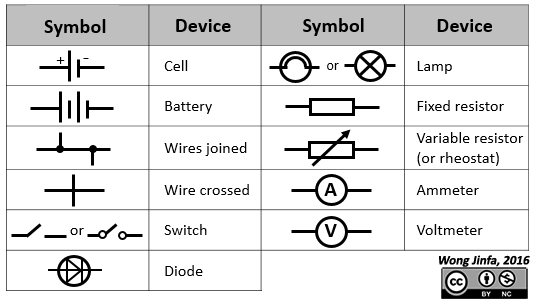¶ Key Understanding:
- Electrical energy is used in many applications in our daily lives.
- We need to understand the effects of electricity and some hazards associated to the use of electricity in the home.
¶ Explain what is meant by current, potential difference and resistance, stating their units.
- Electric current is the rate of flow of electric charge with respect to time (amount of electric charge passing a given point in one second)
- SI unit - Ampere (A)
- One ampere of current means that one unit charge flows in one second
- Conventional current flow is the flow of positive charge from a positively charged end to a negatively charged end
- Electron Flow is the movement of electrons from a negatively charged end towards a positively charged end

- Electric current can be measured with an ammeter (which is connected in a series) ~ accuracy 0.01A

- Electromotive force (e.m.f) is the electromotive force of an electrical energy source is the amount of electrical energy produced by a source per unit charge (work done by the source in driving a unit charge around a complete circuit)
- SI unit - Volt (V)
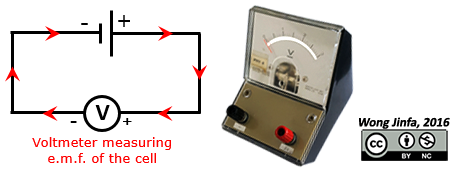
- Potential Difference (p.d.)
- The potential difference between any two points is the amount of energy needed to move one unit of electric charge from one point to another (work done in terms of converting electrical energy to other forms of energy when a unit charge passes between two points of a component)
- SI unit - Volt (V)
- One volt of potential difference means that one joule of energy is needed to move one unit of charge.
- Potential difference can be measured with an voltmeter (which is connected in parallel) ~ accuracy 0.05V
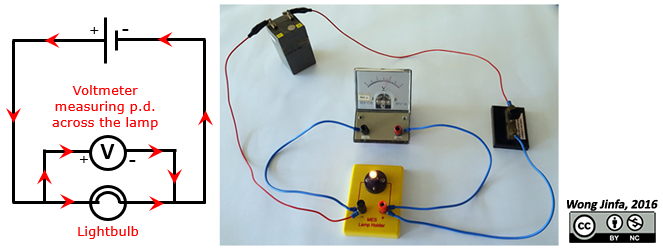
- Resistance of a component is the ratio of the potential difference across it to the current flowing through it
- SI unit - Ohm (Ω)
¶ Draw and interpret circuit diagrams and set up circuits containing electrical sources, switches, lamps, resistors (fixed and variable), ammeters and voltmeters.
- An electric circuit is a complete or closed path through which charges can flow from one terminal of an electrical source to the other terminal.
- It consists of four main components:
- A source of electromotive force that drives the electric charge around the circuit (e.g. a battery)
- A load on which moving charges can do a useful job (e.g. a bulb)
- Conductors to connect the components together (e.g. copper wire)
- Switches to open or close the circuit
- An open circuit occurs when there is a break in the circuit to stop the current from flowing.
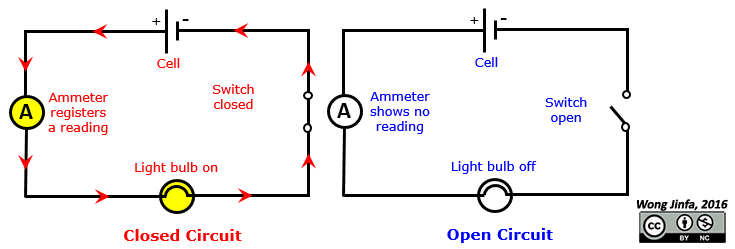
- A resistor is a conductor in a circuit that has a known value of resistance
- They are mainly used to control the size of current flowing in a circuit
- Fixed resistors have fixed values of resistance
- Coloured bands indicate the resistance of the resistor
- Examples include carbon film resistors, carbon composition resistors, tin oxide resistors and wire-wound resistors
- The resistance of a variable resistor can be changed or varied.
- A rheostat is included in a circuit to vary the current flowing through it.

- Ohm’s Law states that the current passing through a metallic conductor is directly proportional to the potential difference across it, provided that physical conditions remain constant.
- I∝V
- R=V/I or V=RI
- Ohmic conductors are conductors that obey the Ohm's law (metallic conductors with resistance that remain constant under steady physical conditions)
- Non-ohmic conductors are conductors that do not obey the Ohm's law (metallic conductors with resistance that vary i.e. V ÷ I is not constant)
- Examples of non-ohmic conductors
- Filament Lamp
- As the potential difference across the lamp increases, the current does not increase proportionally
- The resistance increases as temperature increases, allowing less current to pass through.
- Thermistor
- It is a device whose resistance decreases as the temperature increases, allowing more current to pass through.
- Semiconductor diode
- It is a device which allows current to flow in one direction, called the forward direction.
- In the reverse direction, there is negligible current flow.

- The effective resistance of two or more resistors in a circuit is the combined effect of their presence
- The current in a series circuit (I) is constant throughout
- The electromotive force of the source (V) is given by the sum of the potential difference (Vn) across all the resistors connected in a series, i.e. V=V1+V2+V3
- The effective resistance of a number of resistors (Rtotal) is given by the sum of the resistance (Rn) across all the resistors connected in a series, i.e. Rtotal=R1+R2+R3

- The potential difference in a parallel circuit is constant and equal to the electromotive force of the source
- The total current produced by the source, I, is given by the sum of the current (In) passing through the individual resistors connected in parallel, i.e. I=I1+I2+I3
- Therefore, the reciprocal of the effective (total) resistance of a few resistors is equals to the sum of the reciprocal of each resistance of the resistor, i.e. 1/Rtotal=1/R1+1/R2+1/R3

- Link to Circuit Construction Kit
- Short circuit occurs when current flows through an alternative path of lower resistance instead of through the load
- An ammeter has zero resistance so it should not be connected in parallel to measure current going through a load as a short circuit will occur, i.e. No current will go through the load if it is connected in parallel to the ammeter thus ammeter should be connected in series
- A voltmeter in contrast is connected in parallel to a load as we assume there is negligible or no current that flows through it so that we can get an accurate reading of the potential difference across it

- When the slider is on the left, the short resistance wire offers low resistance
→ The current flowing through the circuit is large, resulting in the light bulb to light up brightly
- When the slider is on the right, the long resistance wire sets up a higher resistance
→ The current flowing through the circuit is smaller, resulting in the light bulb to light up dimly
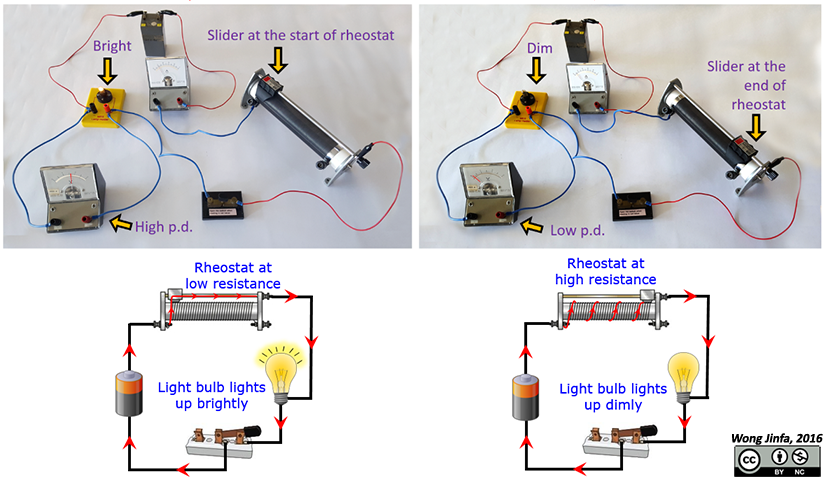
¶ Discuss qualitatively the chemical, heating and magnetic effects of an electric current and list some applications.
- An electric current can cause a chemical change when it is passed through certain liquids.
- Extraction of metals
- Electricity can be used to break down (decompose) compounds into its elements (electrolysis)
- e.g. Aluminum can be extracted from bauxite by passing electricity through the molten form of bauxite
- Electroplating
- Many objects are coated with a metal by immersing the object in a liquid and then passing an electric current through the liquid
- When an electric current passes through a wire, the electrical energy is converted to heat.
- In heating appliances, the heating element is made of materials with high melting points (e.g. nichrome, which is an alloy of nickel, iron and chromium).
- The heating effect of a current can lead to the lighting effect.
- The current flows through the highly-coiled filament.
- The current causes the filament to heat up, which glows and gives out light
- An electric current has an effect on magnets.
- This effect can be seen when an electric current flows near a compass.
- The magnetic effect can be increased by making current flow in a coil of wire called a solenoid.
If an iron rod is placed inside a solenoid, the iron rod becomes a magnet.
- When the current is switched off, the iron loses its magnetism. This set-up is known as an electromagnet.
- Electromagnets are used in the motors of electric fans and DVD drives.
- A strong magnet in the motor interacts with the electromagnet, causing the blades to rotate
- Telephones
- In telephones, a changing magnetic effect causes a thin sheet of metal (diaphragm) to vibrate
- The diaphragm is made of a metal that can be attracted to magnets
- As the person on the other end of the line speaks, his voice causes the current in the circuit to change
- This causes the diaphragm in the earpiece to vibrate, producing sound
¶ Explain what is meant by power and state its units.
- Power is the amount of electrical energy converted to other forms of energy per unit time by the component.
- Power (P)=Potential difference (V)×current (I)
- S.I. unit - Watt (W)
- One watt of power means that in one second, one joule of energy is converted to other forms of energy
- Electrical energy (E)=Power (P)×Time (t)
- Kilowatt-hour (kWh) is the most common unit used to calculate the cost of using electrical energy at home although the SI unit for energy is Joules (J)

- Power bill cost is dependent on the electricity tariff
- The electricity tariff for households was 17.68 cents per kWh (from 1 Apr 16 to 30 Jun 16), i.e. Cost of using an electrical appliance that draws x kilowalts of power for y hours = 17.68xy cents
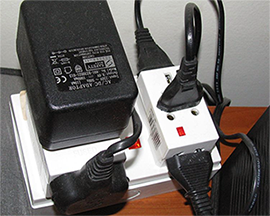
- Occurs when a large amount of current generates heat which may melt the insulation and cause a fire
- Due to overload of power sockets or when electrical circuits are damaged, misused or don't work properly
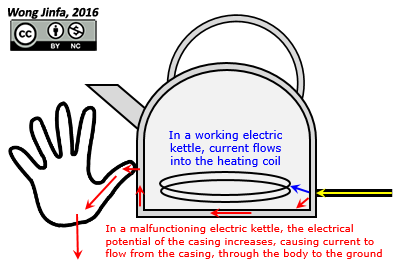
- Occurs when large currents pass through a person’s body from appliances with metallic parts which usually leads to serious injuries or death
- This can happen if we do not switch off electrical appliances and pull out the plug when cleaning them or when electrical appliances are damaged
- In a damaged appliance, the wire at high potential is disconnected from the load and touches the metal casing
- This causes the electric potential of the metal casing to increases so that there is a large potential difference between the ground and the appliance
- Hence, if a person touches the metal casing, a current flows through his body into the ground.
- Do not use electrical gadgets in wet places/do not touch electrical appliances with wet hands
- Switch off the mains and pull out the plug before cleaning electrical appliances
- Avoid the use of old electrical wiring which may expose the wires
- Call an electrician to repair damaged insulation cables
- Never insert any item into an electrical socket
- Avoid overloading an electrical socket
- Flow of a large current in wires or in our body is an electrical hazard.
- Three safety features found in all household electrical circuits to deal with large currents:
- Circuit Breakers
- The circuit breaker in our home is found in the consumer unit
- Each circuit breaker is a switch-like lever connected to a different part of the household circuit
- When a damaged appliance or the damaged part of the circuit is fixed, the circuit can be switched on again using the circuit breaker.
- It can also cut off an electric current but does not need to be replaced like a fuse
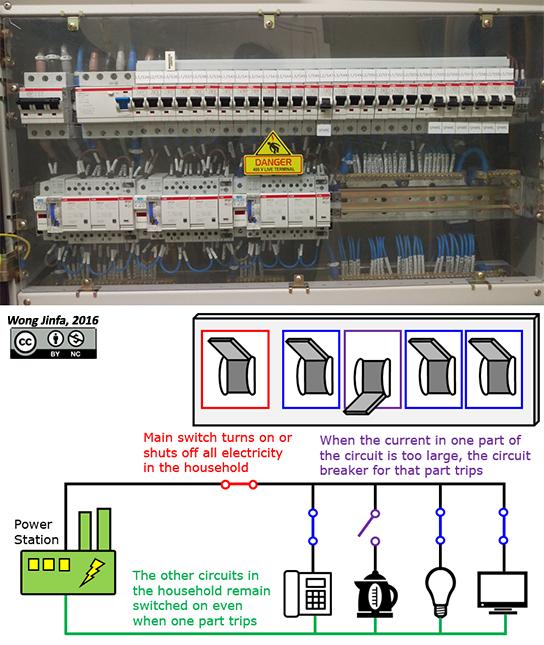
- Fuse
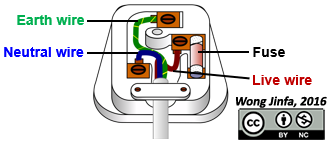
- Fuse makes use of the heating effect of electric current to switch off large current.
- Large current causes short, thin wire in the fuse to heat up and melt (‘blown’)
- A fuse is labeled or rated with the current that will melt the wire
- Common fuse ratings: 3A, 5A, 10A
- A blown fuse should be replaced after an electrical fault has been rectified
- Earth Wire
- There are 3 types of wires found in Singapore's household electrical appliances and plugs
- The live wire (brown) is at a high voltage (set at 240 V in Singapore).
- The neutral wire (blue) is at zero voltage and is where current will usually flow to from the load
- The earth wire (green and yellow) is at zero voltage and is usually connected to the metallic parts to provide a path of low electrical resistance from live wire to the ground or earth (preventing electrocution when an appliance malfunctions)
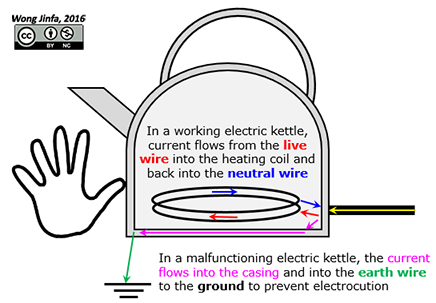
- As the earth wire has a much lower resistance than that of the human body, the earth wire acts as a short circuit causing current to flow directly to the earth via through the earth wire instead of the person who is touching the metal casing.

















